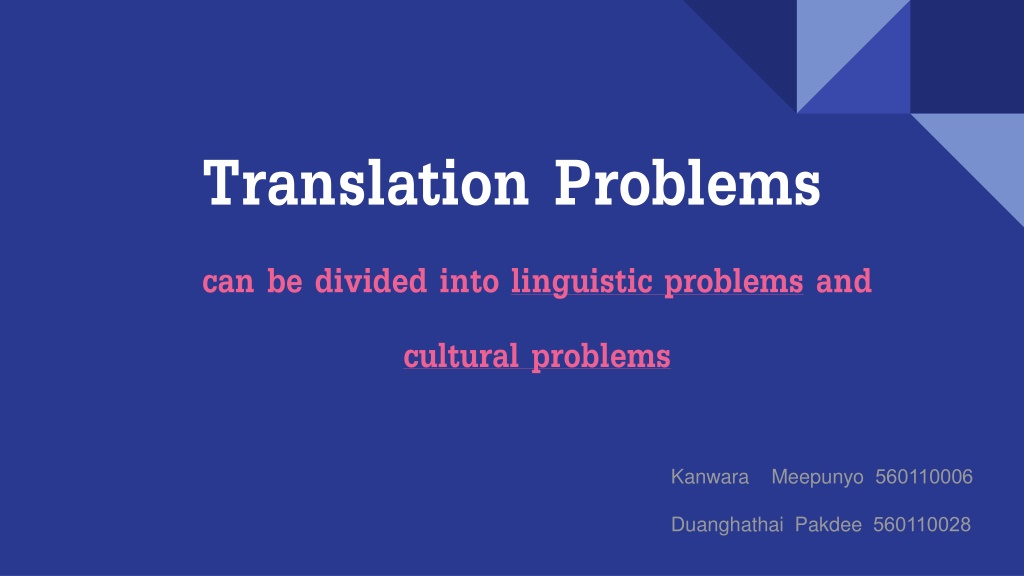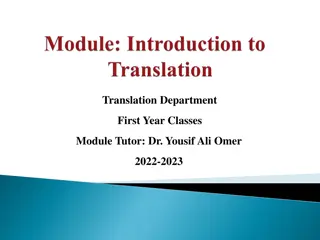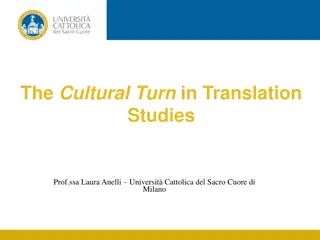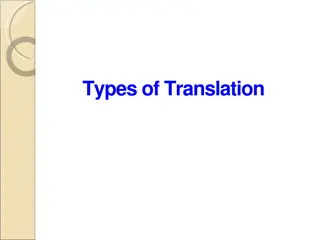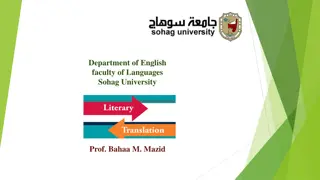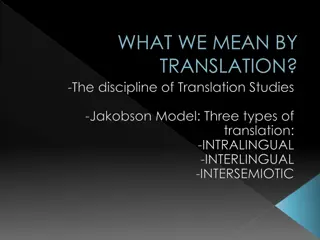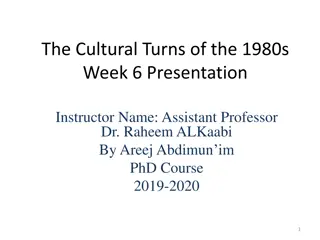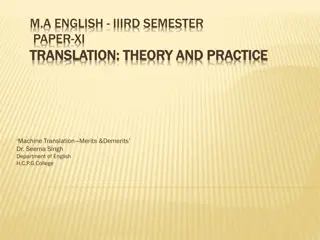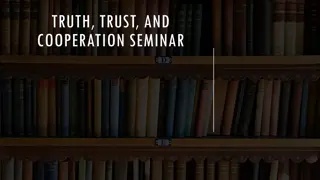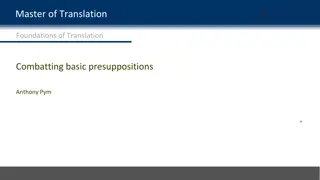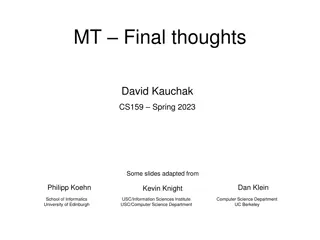Translation Problems
Translation problems can be categorized into linguistic challenges, such as non-equivalence, semantic complexity, distinctions in meaning, form differences, frequency variances. Cultural problems may arise due to differences in grammatical categories like number, gender, and person. Understanding these challenges is crucial for accurate translation.
Download Presentation

Please find below an Image/Link to download the presentation.
The content on the website is provided AS IS for your information and personal use only. It may not be sold, licensed, or shared on other websites without obtaining consent from the author.If you encounter any issues during the download, it is possible that the publisher has removed the file from their server.
You are allowed to download the files provided on this website for personal or commercial use, subject to the condition that they are used lawfully. All files are the property of their respective owners.
The content on the website is provided AS IS for your information and personal use only. It may not be sold, licensed, or shared on other websites without obtaining consent from the author.
E N D
Presentation Transcript
Translation Problems can be divided into linguistic problems and cultural problems Kanwara Meepunyo 560110006 Duanghathai Pakdee 560110028
Linguistic Problems Common problems of non-equivalence (Baker, 2011) 1. The source language concept is not lexicalized in the target language. The source language is known in the target language but there is no equivalent word to express it. SL: appitizer TL:
Linguistic Problems 2. Semantic complexity of the source language. SL: Ex1. BT: envious hot eye TL: feeling envious someone who is better than you SL: Ex2. BT: hurt heart TL: feeling frustrated and angry with oneself for being unable to do something successfully
Linguistic Problems 3. Different distinctions in meaning between source and target language SL: BT: wash the body TL: take a bath or shower The english language make the distinction between take a bath and shower, but in Thai, the phrase does not make distinction.
Linguistic Problems 4. differences in form There is no equivalant of some particular forms in the source and target languages. Prefixes: un, im, in Suffixes: able, ish, ment Thai does not have these equivalent form.
Linguistic Problems 5. Differences in frequency and purpose of using specific forms SL: 1 BT: girl one girl TL: one girl SL: BT: girl 2 girl TL: 2 girls
SL: BT: I do homework. TL: I am doing my homework. SL: BT: I do homework. TL: I did my homework.
Linguistic Problems Grammartical categories across language ( Baker,1992) 1. Number At universities, weekends are usually a time for a massive chill out.
2. Gender John couldn t possibly be her perfect man since she isn t attract to him. 3. Person My old friend jim and I met when we were 17.
4. Tense I am speaking. I ate bananas. 5. Voice John breaks the glass. The glass is broken. 1 . . 2327 . . 2327
Cultural Problems Cultural specific concepts Cultural specific concepts are unknown or rarely understood in the target culture particularly with the concept of religious beliefs, social custom, or type of food. SL: TL: twilight
Differences in psysical or interpersonal perspective & The target language lacks a superordinate A physical perspective concerns with the relationship between people, things and places. SL : , , , , , , , , BT : I TL : I
Differences in expressive meaning SL : BT : important TL : main, major, important, essential, necessary etc.
The use of loan words in the source texts SL : BT : Movie Talung TL : Nang Talung ( the shadow play) SL: TL: Somtum ( Spicy green papaya salad )
The concept of cultural word and phrase categorization (Newmark, 1988) (1) Ecology The results showed that this strategy was found in some Thai seasons. SL: TL: The end of rainy season draws near and the cold season is about to begin This strategy was employed in order to help the foreign readers better understand the meaning of this cultural term.
(2) Material culture SL: TL: A remote temple in the wild SL: 45 TL: A full set of 45 chapters in the Pali Canon which means Buddhist canon was translated as Pali Canon to explained the characteristic of this Canon that is important because it contains many Buddha s teachings.
(3) Social culture TL: , SL: grandmother (4) Religious activities and concepts SL: TL: Pace meditatively (Pacing to and fro, starting from a slow pace and increasing the speed.) SL: TL: Men are immersed in the cycle of birth and death many times over.
SL: TL: Kamma (Volitional Deeds) or the Law of Kamma: All men have their own respective kamma from what they have previously done, be it good or evil. They are obliged to receive its consequences eventually. As illustrated in this example, kamma was borrowed in the target language and Volitional Deeds was added in order to explain the meaning of this Buddhist concept.
(5) Gestures and habits SL: TL: Find a place where you can sit in relative peace. Sit in a lotus position, legs folded on flat ground, with your right foot over your left. In order to clarify, the translator have to explain the characteristic of this position by comparing this position to the lotus in order that the foreign readers can imagine the characteristic of this position.
References Aungsuwan, W. (2011). The Translation of Cultural Terms from Thai into English. Interdisciplinary Discourses in Language and Communication, 29. Baker, M. (2011). In other words: A coursebook on translation. Routledge. Tayjasanant, C. (2013). Principles of Translation: A Textbook for English-Thai/Thai-English Translation Students. Kasetsart University Press. Jeeyasak, s. (2008).A survey of behaviors and problems in translating english into Thai of english major students at Rangsit University. retrieved from https://www.rsu.ac.th/libarts/new/english/ASP_Work1/ISA/SOEMPONG.pdf Newmark, P. (1988). A textbook of translation (Vol. 1, p. 988). New York: Prentice hall.
